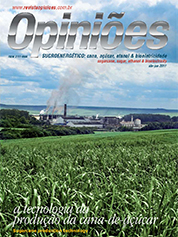Victório Laerte Furlani Neto
Director of Qualimec
Op-AA-28
Soil preparation, systematization, planting and mechanical harvesting
In order to meet growing market demand for sugar and ethanol, one of the available tools is the preparation of lots for the mechanical harvesting of raw sugarcane with the same quality used in soil preparation for planting grain.
Sub-surface fertility analyses make us practice the integrated management of correctives and phosphates, that often enough are out of line compared with the conventional systems that use disk harrows or subsoilers, which seek to achieve cost reductions, but neglect the issue of better in-depth preparation using conventional harrows or moldboard plows that allow seeding at greater depths, the calcification of soil, with better responses from the plant.
Each modification requires a field team, trained to tune tractors and agricultural equipment, so as to, for example, avoid losses resulting from reworking: poorly conducted harrowing, for example, results in many large clumps of soil.
To correct terrain imperfections, the final soil leveling must be done using graders or systematized blades – that allow better mechanical cutting at the stalk base and prevent the swaying that, even in equipment with tracks, places “floating base cutters” at a disadvantage, minimizing the loss of stumps after harvesting.
In expansion areas, in the final leveling operation, one can use a variety of leveling equipment, along with Trifluralin added to the soil, seeking to reduce grass seedlings grass seeding in the ground with grass germinating alongside the new sugarcane plant, thereby requiring chemical and manual treatment, while increasing production costs.
Another aspect to take into consideration in the soil preparation phase is the systematization of planting areas, encompassing management units, better adaptation of areas, the size and direction of furrows, ways to preserve the soil, the right times for planting after intense rainfall, the reduction in the number of unnecessary over head maneuvering or inside blocks, allowing for easy access to sugarcane lot rows.
The lengths of the areas need to be adjusted to the capacity of bin trucks, fertilizers, correctives, and autonomy resulting from the bucket capacity of seed cane planters, the length of fertirrigation rollers, and of special transportation vehicles of chopped sugarcane.
The correct systematization of planting and mechanical harvesting is intended to achieve the high production rates established by equipment suppliers and as planned by the respective production unit, for all activities of a given cycle, from soil correction to harvesting. But even so, at times, we are surprised to see the low rates achieved in comparison with the planned ones. There are several factors in the field contributing to low operational performance.
For mechanical planting, for example, we recommend planting seed cane in the nursery appropriate for mechanical planting; soil leveling in areas targeted for the mechanical cutting of seed cane; maximum seed cane age between 9 and 11 months; systematization of final planting areas – length of furrows x harvesting and planting equipment capacities; harvesting logistics x control; parallelism in planting, among others.
One should match the rates required for mechanical planting, taking into consideration: healthy buds per meter; fertilizers and defensives; damage caused to billets by the seed cane harvester or due to worn knives and the size of the billets; depth under and above the planted billets; standard after planting, error index and stalks per meter.
One should consider efficient ways and places to source seed cane, fertilizers and defensives; the distance between seed cane in relation to the planting area; types of vehicle bodies; adequate power of tractors and equipment; training of staff to seek operational quality rather than quantities produced.
On the sugarcane harvester the “seed cane kit” (an adaptation of the sugarcane harvester for seed cane harvesting) should be installed, entirely enveloped with rubber so as to not damage seed cane buds. It is important that bin trucks or trucks with the seed cane go all the way to the planting equipment, rather than the other way round, and that one be watchful of maneuvering and traffic, and also that one properly plan meeting sites, among other few important factors.
With the adoption of raw unburnt sugarcane, the base cutter without earth became a challenge. Previously, when cane was burnt, invaluable help was provided inside the collector equipment, since most of the earth that came along with the mechanically harvested cane fell from between the conductor rolls on the way up to being cut by the chopper knife.
In raw unburnt cane, one can observe that when the cane is lifted by the feed rolls, the straw bundles the earth together with the stalks that are thrown into the cutting disk. One must find a feasible way to perform this cleaning. To reduce the volume of earth, one may improve the collector equipment extraction chamber by increasing the rotation in the extractor, while also reducing transportation speed.
One may also introduce dry cleaning upon entering the industrial unit, although it is better to not transport earth along to the cutting process, thus preventing the knives from coming into contact with the earth. In any case, it is better to do the cultivation of the plant-cane at the time of the soil leveling, because after the rains the unevenness of the terrain decreases, making it easier to perform the mechanical cutting without earth.




